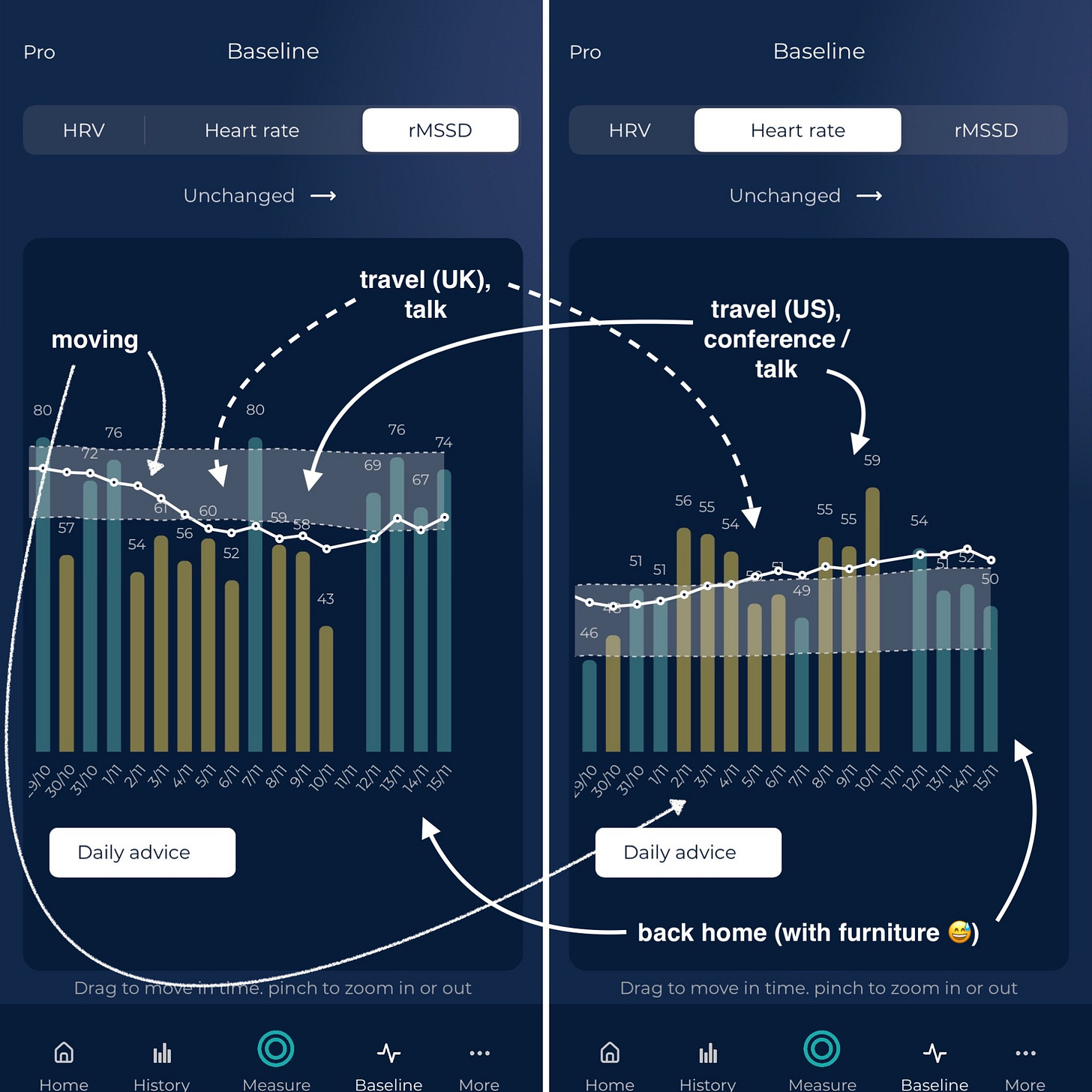Monthly Newsletter: November 2023
heart rate variability, wearables, entrepreneurship, training talk and some ramblings
hi there 👋
I hope all is well.
Here is my newsletter for November, with links to the individual articles I’ve written in the past month. I hope you’ll find them useful.
Please feel free to comment below or in the articles should you have any questions, and I will try to follow up.
Take care!

Heart rate variability (HRV) 🫀
What’s stressing you out? A few weeks ago I shared the image below, showing quite clearly how different stressors impacted me during a few weeks that were quite packed in terms of work commitments. This was of no surprise, of course, and was in line with what I felt during those days. My point here is that since developing HRV4Training (10 years ago!) and working somewhat at the intersection of technology, health, and performance, my interest and understanding of these processes have shifted quite dramatically. Training is hardly ever the (negative) stressor for most of us. Most importantly, training is not an isolated component but interacts with everything else that happens to us. What often causes a negative response, physiologically speaking, is non-training-related stress. This matters because our capacity to assimilate training-related stress is probably dependent on non-training-related stress. Keep reading, here.

You can get the normal range in the Baseline view of HRV4Training by joining Pro, here. Heart rate variability-guided training. HRV-guided training typically tries to modulate training intensity, more the volume why? As per research published about 15 years ago by Stephen Seiler and colleagues, disruptions in autonomic activity (i.e. heart rate, HRV, etc.) are quite marked when exercising at intensities above the first ventilatory threshold (read: non-easy training). On the other hand, training of different durations (e.g. 1 vs 2 hours) but low intensity (i.e. again below the first ventilatory threshold), tends not to show any perturbation in autonomic activity. Learn more, here.
Wearables ⌚️
Measurements vs made-up scores. Wearables these days provide lots of metrics. As a result, it is often confusing for users to determine which ones to pay attention to, and which ones are probably not worth our time. In this blog, I cover the main differences between actual physiological measurements (e.g. your resting heart rate and resting HRV), and made-up scores (e.g. readiness or recovery scores), including useful results from recent research on the topic. When you use a wearable, presumably to measure your body's response to what you are doing (stressors), you have two options: 1) Looking at the physiology. For example your resting heart rate, pulse rate variability, temperature, etc. That's how your body responded. 2) Using a made-up score that includes your behavior and as such, becomes some sort of self-fulfilling prophecy. Keep reading, here.
Podcasts / Talks / articles 🎙️
Royal Society of Medicine. This month I gave a talk at the Royal Society of Medicine about wearables for physiology and sleep tracking. This was a new talk for me (which, in slightly different forms, I will also do in other events, as I normally mostly cover heart rate variability (HRV) alone. I've been thinking about these topics the whole summer: trying to find ways to communicate how wearables can be useful and also their limitations. In this blog, I elaborate a bit more on each point, covering part of what I have discussed in the talk, as well as some of the questions that I was asked, which I think are quite relevant to further clarify a few aspects. Let me know what you think, here.

Gatorade Sports Science Institute. I spoke about wearables also at the GSSI expert meeting in Chicago, covering similar topics. I will add more about this next year as I will be writing a blog for GSSI, and link it here.
Marathon Handbook. I am writing a 4-part guide about heart rate variability for the marathon handbook website. Part 1 is already available here, and covers the physiology of HRV. I hope you’ll find it useful.
Sportsmith. I wrote this other article for Robert Pacey at Sportsmith, covering in practical terms, how we can make effective use of HRV analysis. This includes collecting accurate data, measuring at the right time (i.e. collecting meaningful data), and interpreting that data with respect to a person’s normal range. Read more, here.
Building 🛠️
HRV4Training Pro. I have released the new HRV4Training Pro and have written various articles that can serve as an overview of the different features. You can find the user guide here. I hope you’ll like the new platform, and would like to thank you for your support.
VO2max update. The VO2max estimation page is for runners and cyclists using the Strava or TrainingPeaks integration and training with a heart rate monitor (and power meter in case of cyclists). HRV4Training can estimate cardiorespiratory fitness level (VO2max) based on the relationship between internal (heart rate) and external (pace or power) load. Check out our publication showing a strong agreement between real-life running performance and estimated VO2max. With the latest update, you can also choose between running and biking. See here.

Training talk 🏃🏻♂️🚴
It’s the off-season and I am mostly training high volume while I get over a few niggles. Hopefully back to structured intensity sometime soon, but in the meantime, some good adventures out there.
Training log. As the name says, this is simply my training diary for the year.

Thank you for reading and see you next month!
Archive:
Marco holds a PhD cum laude in applied machine learning, a M.Sc. cum laude in computer science engineering, and a M.Sc. cum laude in human movement sciences and high-performance coaching.
He has published more than 50 papers and patents at the intersection between physiology, health, technology, and human performance.
He is co-founder of HRV4Training, advisor at Oura, guest lecturer at VU Amsterdam, and editor for IEEE Pervasive Computing Magazine. He loves running.
Social:





